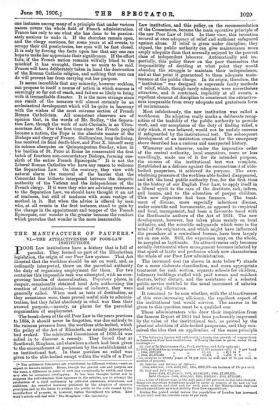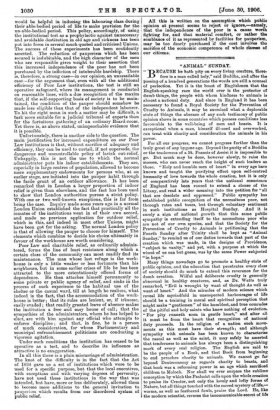THE MANUFACTURE OF PAUPERS.*
VI.—THE ATTRACTIVENESS OF POOR-LAW INSTITUTIONS.
POOR Law institutions have a. history that is full of paradox. They formed no part of the Elizabethan legislation, the origin of our Poor Law system. That Act directed that the workless should be set on work, and, as ordinarily interpreted, threw on the parochial authority the duty of organising employment for them. For two centuries this impossible task was attempted, with an over- growing burden of demoralisation. Populous places, in despair, occasionally obtained local Acts authorising the erection of institutions,—houses of industry, they were generally called. When used as tests of destitution, as they sometimes were, these proved useful aids to adminis- tration, but they failed absolutely in what was then their avowed purpose,—namely, as places for the parochial organisation of employment.
The break-down of the old Poor Law in the years previous to 1834, it should never be forgotten, was due entirely to the ruinous pressure from the workless able-bodied, which the policy of the Act of Elizabeth, as usually interpreted, had evoked. The celebrated Commission of 1832-34 was called in to discover a remedy. They found that at Southwell, Bingham, and elsewhere a check had been given to the encroachment of pauperism by the establishment of an institutional test. In these parishes no relief was given to the able-bodied except within the walls of a Poor [4 The articles in this series are contributed by different writers,—each an expcirt•in his own subject. Hence, though the general aim and purpose are the same, a difference in point of view may occasionally be visible, and there may also be occasional overlapping. It has been thought better not to suppress the individualism thus apparent in the articles, nor to attempt the pied:action of a rigid uniformity by editorial omissions, alterations, and additions. ..&n essential harmony produced by the adoption of common principles, and by the desire to awaken the public to the evils caused by the nianufacture of wipers, is, however, visible throughout the series. Nett week's a*tic.le will deal with "The Hospitals."—En. Spectator.] Law institution, and this policy, on the recommendation of the Commission, became the main operative principle of the new Poor Law of 1834. In their view, this invention secured at once adequacy of relief and sufficient safeguard against abuse. If relief is given under discipline, they argued, the public authority can give maintenance more amply adequate than that normally enjoyed by the poorest class of independent labourer. Automatically and im- partially, this policy threw on the poor themselves the responsibility of deciding at what point they would abandon the struggle to maintain their independence, and at that point it guaranteed to them adequate main- tenance at the public charge. In its origin, therefore, the " institution " was designed to supersede faulty methods of relief, which, though rarely adequate, were nevertheless attractive, and it contained, implicitly at all events, a repellent element of discipline to counteract the attractive- ness inseparable from every adequate and gratuitous form of maintenance, Most infelicitously, the new institution was called a workhouse. Its adoption really marks a deliberate recog- nition of the inability of the public authority to provide work, and our acceptance of the duty of finding relief, a duty which, it was believed, would not be unduly onerous if safeguarded by the institutional test. The subsequent development of an institution created for the emergency above described has a curious and unexpected history.
Whenever and wherever, under the imperative order of the central authority, local executives, more or less unwillingly, made use of it for its intended purpose, the success of the institutional test was complete. Established as a defence against the encroa,clime it of able- bodied pauperism, it achieved its purpose. The over- whelming pressure of the workless able-bodied disappeared, and left bthe local public authority free, for the first time in the history of our English Poor Law, to apply itself in a liberal spirit to the care of the destitute, sick, infirm, and insane, and to the education of pauper Children. This new departure had been foreseen. The treat- ment of disease, more especially infectious disease, under scientific and bureaucratic, as opposed to empirical and local, management, had been a favourite tenet with the Benthamite authors of the Act of 1834. The new development, however, has taken place mainly ou local initiative, and the scientific safeguards which were in the mind of the originators, and which might have influenced the procedure of a centralised bureau, have been largely set on one side. Still, the expansion may, on the whole, be accepted as legitimate. Its attractiveness only becomes socially detrimental when management becomes infected by that spirit of laxity and profusion which now characterises the whole of our Poor Law administration.
The increased cost (as shown in note below *) stands for a more elaborate classification, and more appropriate treatment for each section, separate schools for children, infirmary buildings staffed with paid nurses and resident doctors, better dietary, and the assistance of a selected public service entitled to the usual increment of salaries and retiring allowances.
It remained to be seen whether, with the attractiveness of this ever-increasing efficiency, the repellent aspect of the institutional test would survive. The answer to be given to this question must be a qualified one.
Those administrators who drew their inspiration from the famous Report of 1834 had been profoundly impressed by the value of the institutional test, as proved by the practical abolition of able-bodied pauperism, and they con- ceived the idea. that an application of the same principle • The following figures will sufficiently in hcate the growth of expenditure in'London on Pour Law institutions. Officially the cost is given under three headings :— (1) Cost of In•Maintsnancs (i.e., food, clothing, and daily upkeep) : In 1894, 5810,434 for an average number of 52,979 paupers =512 1 9 per head „ 1894, 5871,221 „ 83.451 „ .ael 14 7 „ 1904, 21,179,09071,474 „ w51.13 9 8 —an increase in twenty years of St per ceut. iu cost and of 3.5 per cent. in number of paupers.
(2) Salaries and Balions o Officers: 1594, £418,9:43; 1994, 2812,768 ; 1901, 2999,373—an increase of 138 per mut.
(3) Debt and Debt Charges: Debt-199k, 0,294,653 ; 1891, £3,919,28i; 1901, 57, • %.572 ;
Debt Charges—IS:34, 2215,562 ; 1891, 4162,037; 1901. 2739,666;
a rise of 142 per cent. in the debt and of 199 percent. in the' debt charges, Some not important deductions might be made iu respect of (2) and (3) fur outdoor salaries and debt and for such part of the Metropolitan Asylum* Board expenditure as is not strictly Poor Law expenditure. •
During the period under review the population of London has increased 18 per cent. and the rateable value 41 per cent.
would be helpful in inducing the labouring class during their able-bodied period of life to make provision for the un-able-bodied period. This policy, accordingly, of using the institutional test as a prophylactic against unnecessary and avoidable destitution in old age and sickness has been put into force in several much quoted and criticised Unions. The success of these experiments has been confidently asserted. The reduction of pauperism which has been secured is indubitable, and the high character of the men who are responsible gives weight to their assertion that this increased independence of the poor has not been purchased by the infliction of intolerable hardship. There is, therefore, a strong case—in our opinion, an unassailable case—for the argument that, even with all the additional efficiency of Poor Law institutions, the test is still an operative safeguard, where its management is conducted on reasonable lines, with a due recognition of the maxim that, if the self-supporting basis of society is to be main- tained, the condition of the pauper should somehow be made less eligible than that of the independent labourer.
To hit the right mean in such a matter may be difficult, a task more suitable for a judicial tribunal of experts than for the fortuitous gathering of an ordinary Board-room. Yet there is, as above stated, unimpeachable evidence that it is possible.
Unfortunately, there is another side to the question. The main justification for increased expenditure on our Poor Law institutions is that, without sacrifice of adequacy and efficiency, they can be used to curtail, if not supersede, the dangerous and uncontrollable policy of lavish out-relief. Unhappily, this is not the use to which the normal administrator puts his indoor establishments. They are, especially iu large centres of population, allowed to become mere supplementary endowments for persons who, at an earlier stage, are initiated into the pauper habit through the facile grant of an outdoor allowance. It has been remarked that in London a larger proportion of indoor relief is given than elsewhere, and the fact has been used to show that London authorities pursue a strict policy. With one or two well-known exceptions, this is far from being the case. Inquiry made some years ago in a normal London Union established the fact that practically all the inmates of the institutions went in of their own accord, and made no previous application for outdoor relief, which in this, and indeed in most other Unions, might have been got for the asking. The normal London policy is that of allowing the pauper to choose for himself. The elements which combine to decide his choice ultimately in favour of the workhouse are worth considering.
Poor Law and charitable relief, as ordinarily adminis- tered, forms the line of least resistance along which a certain class of the community can most readily find its maintenance. The man whose last refuge is the work- house is only a little weaker or less fortunate than his neighbours, but in some earlier crises of life he has been attracted to the more ostentatiously offered forms of dependence. He then attaches himself permanently to some private or public agency of relief, and sinks in the process of such experience to the habitual use of the shelter or the casual ward, till at length he realises, what indeed is the fact, that the accommodation of the work- house is better ; that its rules are lenient, or, if irksome, easily evaded; that readily granted leave of absence makes the institution a free and easy house of call; that the sympathies of the administrators, whom he has helped to elect, are with him against any official wbo attempts to enforce discipline ; and that, in fine, he is a person of much consideration, for whose Parliamentary and municipal enfranchisement politicians are conducting a vigorous agitation.
Under such conditions the institution has ceased to be operative as a test, and to describe its influence as attractive is no exaggeration.
In all this there is a plain miscarriage of administration. The knot of the difficulty is in the fact that the Act of 1834 gave us a set of institutions which were to be used for a specific purpose, but that the local executives, with exceptions and with varying degrees of perversity, have not used these institutions in the way that was intended, but have, more or less deliberately, allowed them to become mere additions to the general invitation to pauperism which results from our disordered system of public relief. IAll this is written on the assumption which public opinion at present seems to reject or ignore,—namely, that the independence of the poor is a cause worth fighting for, and that material comfort, or rather the semblance of it as represented by facilities for pauperism, may be too dearly purchased if the cost involves the sacrifice of the economic competence of whole &ens of our citizens.



























































 Previous page
Previous page